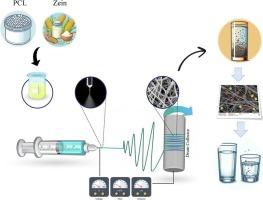Innovative electrospun zein/polycaprolactone nanofibers loaded with graphene oxide: A superior adsorbent for effective lead ion removal from drinking water
IF 4.6
3区 材料科学
Q2 MATERIALS SCIENCE, MULTIDISCIPLINARY
引用次数: 0
Abstract
This study explores the use of electrospun nanofibers (NFs) composed of zein and polycaprolactone (PCL) incorporated with graphene oxide (GO) nanoparticles for the removal and adsorption of heavy metals, specifically lead (Pb2+), from water. The NFs were characterized using spectroscopic techniques including X-ray diffraction, Fourier-transform infrared spectroscopy (FTIR), scanning electron microscopy (SEM), and thermogravimetric analysis (TGA), which provided information about molecular interactions, morphology, crystallinity, thermal stability, and hydrophobicity. The average fiber diameter was approximately 776 nm, and the surface contact angle was measured at 90°, indicating hydrophobic properties. The NFs displayed semi-crystalline behavior and exhibited significant thermal degradation above 350 °C. Under optimal conditions—temperature of 30 °C, pH of 6, contact time of 30 to 90 min, and lead concentration between 1 and 25 mg/L—the Zein/PCL/GO NFs achieved over 85 % removal efficiency of Pb2+. The adsorption behavior aligned well with the Langmuir isotherm, and the kinetics were accurately described by a pseudo-second-order model. These results demonstrate that the NFs serve as high-capacity, efficient, and cost-effective adsorbents for heavy metal removal in water treatment applications.

负载氧化石墨烯的新型电纺丝玉米蛋白/聚己内酯纳米纤维:一种有效去除饮用水中铅离子的优越吸附剂
本研究探索了利用由玉米蛋白和聚己内酯(PCL)组成的静电纺丝纳米纤维(NFs)与氧化石墨烯(GO)纳米颗粒结合,去除和吸附水中的重金属,特别是铅(Pb2+)。利用x射线衍射、傅里叶变换红外光谱(FTIR)、扫描电镜(SEM)和热重分析(TGA)等光谱技术对纳米颗粒进行了表征,提供了分子相互作用、形态、结晶度、热稳定性和疏水性等信息。纤维平均直径约为776 nm,表面接触角为90°,具有疏水性。在350°C以上,NFs表现出半结晶行为,并表现出明显的热降解。在温度为30℃,pH为6,接触时间为30 ~ 90 min,铅浓度为1 ~ 25 mg/ l的最佳条件下,Zein/PCL/GO纳米颗粒对Pb2+的去除率达到85%以上。吸附行为与Langmuir等温线吻合较好,动力学用拟二阶模型准确描述。这些结果表明,在水处理应用中,NFs是一种高容量、高效、经济的重金属去除吸附剂。
本文章由计算机程序翻译,如有差异,请以英文原文为准。
求助全文
约1分钟内获得全文
求助全文
来源期刊

Materials Science and Engineering: B
工程技术-材料科学:综合
CiteScore
5.60
自引率
2.80%
发文量
481
审稿时长
3.5 months
期刊介绍:
The journal provides an international medium for the publication of theoretical and experimental studies and reviews related to the electronic, electrochemical, ionic, magnetic, optical, and biosensing properties of solid state materials in bulk, thin film and particulate forms. Papers dealing with synthesis, processing, characterization, structure, physical properties and computational aspects of nano-crystalline, crystalline, amorphous and glassy forms of ceramics, semiconductors, layered insertion compounds, low-dimensional compounds and systems, fast-ion conductors, polymers and dielectrics are viewed as suitable for publication. Articles focused on nano-structured aspects of these advanced solid-state materials will also be considered suitable.
 求助内容:
求助内容: 应助结果提醒方式:
应助结果提醒方式:


